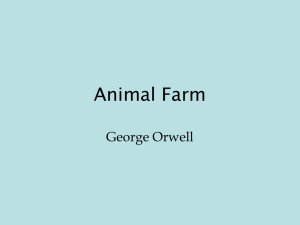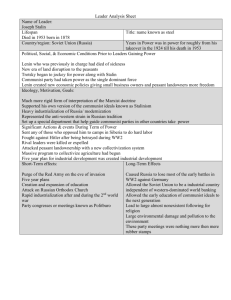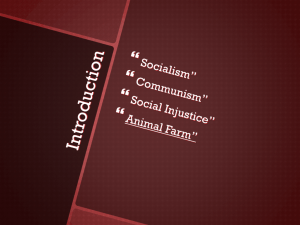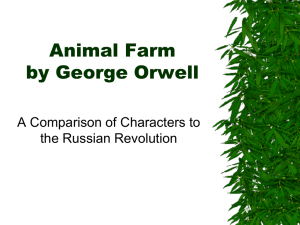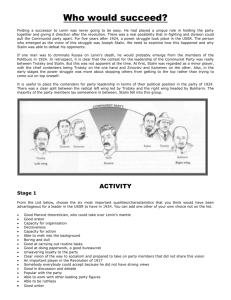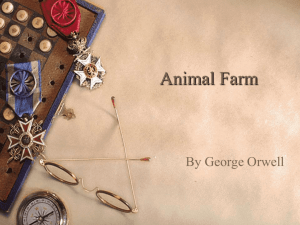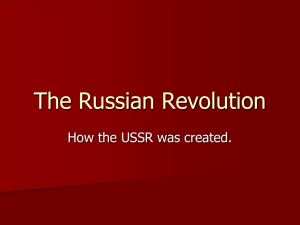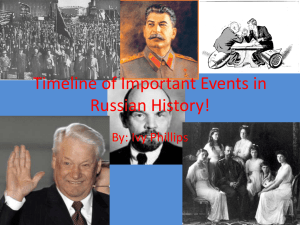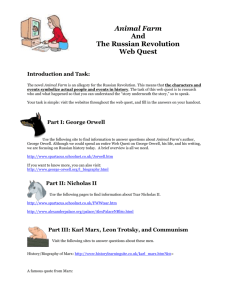Animal Farm by George Orwell
advertisement
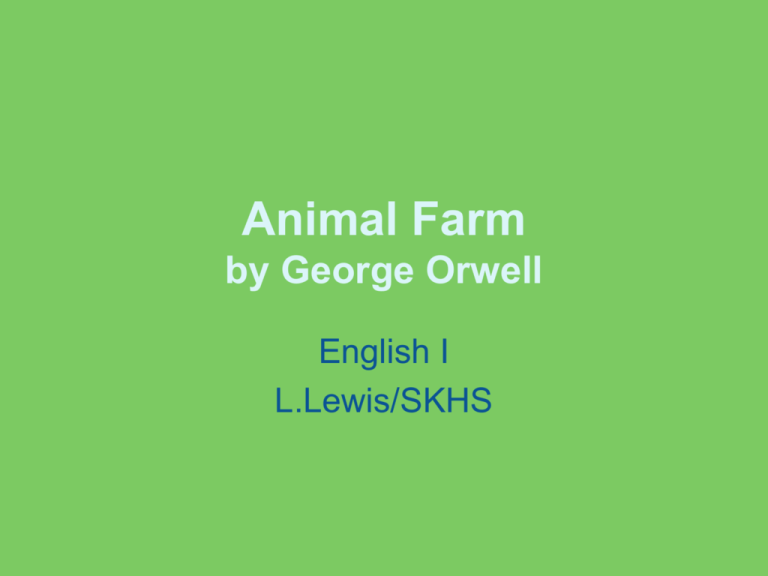
Animal Farm by George Orwell English I L.Lewis/SKHS George Orwell • Originally named Eric Blair, he adopted the name Orwell because it sounded more English • He spent his early years in India and liked to make up stories. For school, his parents sent him to a boarding school in England. George Orwell • Instead of going to college, Orwell took a job in Burma and wrote about the oppression of the British • Years later he returned to England writing newspaper columns, essays, and radio broadcast • During WWII he supported England but was skeptical of government and their willingness to forsake ideas for the sake of power. A theme he uses in Animal Farm. The novel is a direct allegory of the Russian Revolution Pre-Russian Revolution • In America and Europe, a capitalist system was thriving. A capitalist system is a free enterprise system demonstrating under the philosophy that if you work hard, you can get ahead. • In 1847, Karl Marx a German philosopher drew up a plan to help a group of international workers. Marx came up with a plan called The Manifesto of the Communist Party. Pre-Russian Revolution • Marx envisioned a workers revolt where workers would work according to their ability and their need. The final stage of his plan was a communist system or economic quality. • Communist System- a theory based on holding all property in common and ownership belongs to the community. Pre-Russian Revolution • At this time, in America and Europe were passing labor laws and make places safer and more tolerable. The worldwide revolution Marx had hoped for would never come to pass. • There were still many people who followed Marx, they were called socialist, who wanted to bring change to society. Pre-Russian Revolution • The socialist were split into two groups. The milder group wanted to bring change slowly by passing laws. The other group (later called the communist) followed Marx’s idea for a major revolt. • They (the socialist and communist) formed a party called the Bolshevik party. Timeline • 1864-Marx organizes the First Communist Internationale in London. It directs a modest growth in Communism. • 1881-Revolutionary dissent in Russia, a growing dissatisfaction with the political system and general conditions. • 1883-Karl Marx dies Timeline • 1917- The February Revolution, growing out or violent street protest against the war and poverty it contributed to, finally topples Czar Nicholas. – Nicholas ran Russia like a king, workers were underpaid and worked on land of wealthy landowners. – The Bolshevik party successfully overthrew the Czar. Timeline • 1917- At the October Revolution the Bolshevik troops advance on the Provisional Government Headquarters at the Winter Place. A bloodless coup brings the Soviets to power, and marks the start of the Communist Era. Timeline • 1918- Civil War begins in Russia. White forces intent on moving the Soviets from power, battle “Red” forces of communist Russia under the leadership of Leon Trotsky. Trotsky’s skillful execution of the three-year war effort result in the maintenance of communist authority. Timeline • 1922- The USSR is formally established • 1924-1927- Stalin outmaneuvers Leon Trotsky and assumes full command of the USSR. He immediately begins the process of isolating Trotsky within the party; eventually (1927) Trotsky is run out of town and exiled to Alma-Alta. Timeline • 1928- Stalin announces the first Five Year Plan an ambitious attempt to make Russia a modern industrial state. Stalin exhorts his “comrades” throughout the Soviet Union to work harder than they ever have so that Russia could be a beacon of hope everywhere. Timeline • 1933-Stalin proposes a second Five Year Plan which again emphasizes the rapid growth of Soviet Industry. By the end of the second Five Year Plan, Soviet Russia was a formidable world power. • 1934-The beginnings of “Great Purges” and “show trials” under Stalin. These public accusations and forced confessions were followed by quick trials and executions. Between two and seven million are suspected of opposition to Stalin and are executed. Timeline • 1939- The German-Soviet Non Aggression Pact, a secret agreement between Joseph Stalin and Adolph Hitler was signed. This pack guaranteed that neither country would oppose or attack the other. Timeline • 1941-Adolph Hitler begins “Operation Barbosa” the full frontal assault of the Soviet Union, in defiance of the 1939 Treaty. Hitler quickly moves into Russia, straining its supply lines and trapping his troops deep within Russia. Winter, followed by sapped German troop strength, and they began to retreat under Russian counterassault • 1943-Stalin, Winston Churchill, and Franklin D. Roosevelt met to discuss the ways to forge a lasting peace after the war. Vladimir Lenin • Student of Marxism • Leader of Bolshevik party • Creator of the Secret Police • Civil Wars • Assassination attempts Leon Trotsky • A leader in the Bolshevik party • Formed the Red Army • Denounced the work of fellow Bolshevik Joseph Stalin • Became the scapegoat for many of Russia’s problems • Exiled to Mexico where is he was assassinated Joseph Stalin • Before coming into power, he wrote for the Pravda, a party newspaper. • Secretary of the Central Committee (a place where he could control appointments, set agendas and transfer party officials and increase power) • When Lenin died, Stalin used power to become a dictator in 1929. Joseph Stalin continued • He planned to industrialize his nation • He wanted to use collectivization to increase production and to end private farming. • He transferred control of the farms to the government, causing people to starve and revolt. • In 1935, he began the Great Purge in which no one was able to escape the terror of his rule. • By 1938 he gained absolute power. Joseph Stalin • In 1939 he went into an agreement with Germany for their safety during the war. In 1941, Germany invaded Russia. • In 1943, Stalin met with Roosevelt and Churchill to work together until Germany was defeated. • In 1945, the leaders met again to discuss occupying Germany • In 1953, Stalin died. Russian Revolution • Marx’s system turned into a system more terrifying than the czars. There was no freedom, it was a totalitarianism. Things you need to know • An allegory- a story with a double meaning. Although Animal Farm is a story about animals. It is a message speaks about human nature and what power can do to someone. • Satire- the writer attacks a serious issue by presenting it in a ridiculous manner. Orwell uses satire to expose the myth of Soviet Socialism. Types of Government A simple explanation…using cows • Capitalist- You have two cows, you sell one and buy a bull. (if you work hard, you can get ahead) • Communist- You have two cows. Your neighbors help you take care of them. You all share the milk. – Russian Communism- You have two cows. You have to take care of them, but the government takes all the milk. Types of Governments continued • Socialist- You have two cows. The government takes them and puts them in a barn with everyone else's cows. You have to take care of all the cows. The government gives you as much milk as you need • Totalitarianism- You have two cows. The government takes them and denies they ever existed. Milk is banned. Other Terms • Republic- state of power rest in citizens entitled to a vote and is exercised by representatives chosen directly or indirectly. • Proletariat-workers who do not possess capitol or property and must work to survive • Autocracy-one person who has absolute power. Cast of Characters • • • • • • • The Pigs Old Major Snowball Squealer Minimus Pinkeye Piglets Rebel Pigs The Humans • • • • Mr. Jones Mr. Frederick Mr. Pilkington Mr. Whymper Other Animals Horses: • Boxer • Clover • Mollie Donkey: Benjamin Characters • Raven: Moses Goat: Muriel Characters • • • • • Dogs: Jessie and Bluebell The Hens The Dogs The Sheep The Cat
